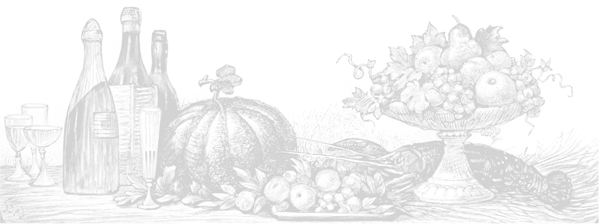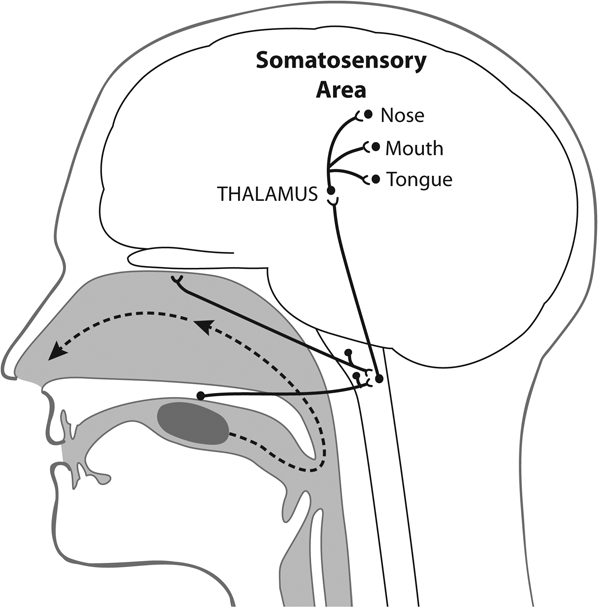

In addition to having a smell and a taste, every kind of food and drink has physical properties that give it a feel in the mouth. This feel is the result of so many senses that it is difficult to summarize in one name, so we call it variously mouth-sense, mouth-feel, or food-texture. This sensation is something we prejudge when we take the food to consume it. We compare this expectation against the actual sensation in the mouth as part of judging the quality of the food. Mouth-sense is mediated by the somatosensory (somato = body) system, which encompasses a range of sensory submodalities that include touch, pressure, temperature, and pain. These somatosensory fibers add many important sensory qualities to the taste in our mouths and the smell in our noses, combining with them in the unified perception of flavor.
The Receptors in the Mouth
There are several kinds of somatosensory receptors in the skin of the lips and cheek and inside the mouth on its membranes and on the tongue (box 14.1). The receptors are similar to those in other parts of the body, except that they are present in very high density. Obviously the mouth cares a great deal about the feel, the texture, the temperature, and the potential noxious quality of what it takes in.
BOX 14.1
Somatosensory (Mouth-sense) Receptors
Temperature-sensitive terminals come from very small slowly conducting nerve fibers. They have molecular receptors called Transient Receptor Potential (TRP: pronounced “trip”) channels that can sense cooling or warming of the skin or membrane. They sense hot food and coffee, ice cream and cold drinks.
Pain-sensitive terminals come from small fibers. The painful stimuli may be mechanical, chemical, or temperature. TRP channels have been implicated in some of these responses. Depending on how the terminals are activated, they can give sticking pain, burning pain, aching pain, and almost any other kind of pain you have experienced or can imagine. They are what give many their delight or unhappiness on consuming hot peppers (capsaicin).
Touch-sensitive terminals come from medium-size faster nerve fibers. They can sense small depressions, roughness, and stretching of the skin and membrane, such as while we are chewing. TRP channels appear to be involved here, too.
Pressure-sensitive terminals (Pacinian corpuscles) are extremely sensitive to mechanical vibration. They respond quickly but transiently to pressure such as vibration from rapid tongue and jaw movements.
The Receptors in the Nose
Not to be forgotten are the somatosensory fibers in the nose. In analogy with the mouth, we can say that they are responsible for “nose-sense” or “nose-feel.” These are thin nerve fibers with receptors in their terminals in the membrane lining the nasal cavity. They are activated by certain kinds of volatile chemicals, such as the vapor of ammonia; by physical properties such as those of carbonated drinks; by a rapid rush of air through the nasal cavity when sniffing; and by moderate-to-high concentrations of many kinds of smell molecules. Psychologists studying the psychophysical properties of different smell molecules have to control carefully for whether a smell perception is due partly to these somatosensory receptors in addition to the smell receptors. There is evidence that the smell receptor cells can also respond to mechanical stimulation by the air stream, making smell itself a multimodal sense. So except for very quiet breathing, somatosensation is always present when we smell.
The Many Textures of Food
The array of sensory receptors in our lips, mouths, and tongues is matched by the array of physical and chemical properties of the foods and drinks we put in our mouths. This interaction gives rise to the large number of sensory qualities that we call the mouth-feel or mouth-sense: the touch, feel, and texture of the food and liquids in our mouths. Here we note just a few of them.
As box 14.2 indicates, the somatosensory system is critical for testing the state of the food. Humans place a high value on the many mouth-feel properties we look for in different foods. Free endings in the tongue and membranes of the cheeks and palate, and even in the teeth, signal crispness, smoothness, chunkiness, stiffness, softness, springiness, rate of fragmentation as we chew, and readiness to be swallowed—to name just a few qualities. The acceptability of French fries, for example, depends on how crisp they are as well as on their taste and smell. Few enjoy breakfast if the cereal flakes have become limp in the humidity because someone neglected to close the package tightly (one of my pet gripes).
BOX 14.2
Qualities of Mouth-Sense: Touch, Feel, and Texture
Pain commonly signals something to be avoided. It is used, together with the touch receptors, to reject sharp objects like fish bones that could be life threatening if swallowed. Anyone who has eaten whole fish knows how thoroughly the fish meat is turned over and over in the mouth so that any tiny bone can be detected by a sharp touch or pricking pain and rejected.
Pain is a special case for flavor. Most people reject a food that causes pain in the mouth, particularly burning pain. However, many people learn to tolerate and prize the pain wrought by the capsaicin molecules in chili peppers as an essential part of the flavor of the foods they are in. This is an example of how the hardwired aversive behavioral responses at birth can be overcome by learning.
The Touch Pathway to the Cortex
The receptors for all these qualities are on the tips of nerve fibers that belong to the fifth cranial nerve, called the trigeminal nerve. From the nose and mouth, the impulses travel to the trigeminal ganglion and into the trigeminal nucleus in the brain stem (figure 14.1). Like taste fibers, their entry is at the level of control of vital functions, as one might expect for an input carrying signals of pain that require an immediate reaction.
The output cells send their axons to the somatosensory nucleus in the thalamus, from where the axons are relayed to the somatosensory area of the cerebral cortex. The fact that the sensory endings in the mouth and tongue are densely packed implies a correspondingly large amount of cortex to analyze these responses, and that is exactly what is found. The neurosurgeon Wilder Penfield in Montreal showed this in the 1950s. He carried out the first operations on humans for relief of epilepsy, which involved opening the brain case to expose the entire cortex surface. This enabled him to locate the sensory and motor areas so that he could avoid interfering with them. He was able to map out the body surface on a strip of cortex and show that there is a regular sequence from the toes to the head, and that it varies in size depending on how sensitive the body parts are to touch. The largest areas were the fingers, lips, and tongue. The fingers bring food to the lips, which together with the tongue and other receptors in the mouth sense it while it is being chewed and swallowed; these actions represent a large proportion of the somatosensory part of the brain, all devoted to the touch dimension of flavor. An increase in activity of these areas in obese individuals will be discussed in chapter 21.

FIGURE 14.1 The human somatosensory system
It appears that conscious localization of the touch sensations to the nose and mouth occurs at this neocortical level. Just as we can relate individual types of smell molecules to their spatial patterns in the olfactory bulb, so can we relate specific types of touch sensations to their receptors in the mouth. However, the sensations that contribute to the unified sensation of flavor must involve further connections between those areas and the cortical areas for taste and smell.
Interactions of Touch with Taste and Smell
We have indicated that flavor is a multisensory sensation. It is now becoming apparent that it involves much more than simply summing up the different senses that contribute to it. They interact in many ways with each other, beginning with the receptors and continuing all the way up to the cerebral cortex. Some of these effects and interactions that contribute to the perception of flavor have been reviewed by Justus Verhagen and Lina Engelen in 2006 and are summarized in box 14.3.
These interactions are only a few of the many that have been studied in the laboratory and that are, of course, known in traditional cuisines. It hardly needs to be pointed out that it is precisely these interactions that are the focus of so much interest in the manipulations of different food compounds that underlie the drive to create new kinds of cuisines, including the sometimes noncongruent ingredients that are explored in molecular gastronomy. It seems inevitable that increased knowledge of the brain mechanisms involved will enhance these explorations.
BOX 14.3
Interactions of Touch with Taste and Smell
Effects Between Submodalities of Touch
Temperature on touch: Differences in temperature affect the perception of the texture of a substance in the mouth. These perceptual differences may be due to peripheral or central effects.
Temperature on irritation: The hot burning quality of pain produced by capsaicin is reduced by cooling and increased by warming.
Irritation on temperature: Irritants, such as capsaicin, increase the perceived intensity of warmth and reduce the perception of coolness.
Effects Between Touch and Taste
Taste on touch: Sweet makes substances feel more viscous (thicker), whereas sour makes them feel less viscous.
Touch on taste: Stimulating one part of the tongue containing taste buds and then another part without taste buds makes the subject think that the stimulus is working in both parts. This is known as tactile capture. It reflects the fact that every aspect of flavor is referred to where the stimulus is located.
Temperature on taste: Sensitivity to tastants is highest at normal mouth temperature (between 71.6 and 98.6°F [22 and 37°C]).
Taste on irritation: Pain due to capsaicin reduces sensitivity to the different tastes (sweet, sour, salt, bitter, and umami).
Temperature and viscosity on taste: Increasing heat releases more taste molecules from a substance in the mouth, which—combined with lower viscosity from the heat—facilitates stimulation of the taste buds. This is why hot food tastes stronger, especially cooked meats. These are physicochemical effects in the mouth that are relayed up the pathways to the cortex to give stronger perceptions of flavor.
Effects Between Touch and Smell
Touch on smell: Increasing the viscosity of a gel in the mouth reduces the perception of retronasal smell. This could be due to a peripheral interaction (less release of smell molecules) or central interaction (convergence of sensory inputs in the cortex).
Temperature on smell: Increasing heat releases more volatile compounds and hence stimulates the olfactory receptors more strongly by retronasal smell. This is one reason you want your coffee hot.
Smell on irritation: Orthonasal odor stimulation inhibits orthonasal irritating stimulation.
Irritation on smell: When delivered together, the irritant suppresses the odor. Stimulation with capsaicin inhibits the perception of flavors.